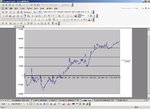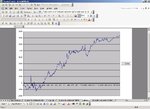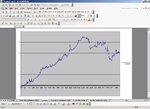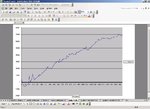FetteredChinos
Veteren member
- Messages
- 3,897
- Likes
- 40
da rulez......
right, same as before. Fade the direction of the last 4 days:-
if the last 4 days have been bullish, go short, if they have been bearish, go long.
now the exit is where things get interesting. (and bizarrely simple)
at the end of each 2 month period, close off all trades from the previous 2 months, and then start again from a flat position, buying low and selling high, and close off after another two months.
the attached spreadsheet will probably make things clearer....
during january and february we buy and sell at the close depending on the previous 4 days action. when we hit 1st of March, we close off any open positions so we end up flat. then for march and april we do the same, buying and selling each day. then closing off on 1st May.
repeat ad nauseam.
at the most this can end up with 40 positions open at one point (unlikely!) which is why you may need a sizeable coconut to trade this without the drawdowns becoming lairy.
in terms of simplicity, this does take the biscuit, and its not a garribaldi.
if someone can point out any obvious flaws, i would appreciate it.
ps, i havent tried any other "settlement dates" as i cant work out how to code the thing in excel. dont see it affecting things too much. i tried not having settlement dates at all, and that would have returned about 80,000 points, but is currently in drawdown, and also the equity curve was diabolique..
its getting silly now, the next thing is for me to start recommending Buy and Hold:-
on the 1st january each year, buy the 5 highest yielding stocks of the Dow 30 zzzzzzzzzzzz
right, same as before. Fade the direction of the last 4 days:-
if the last 4 days have been bullish, go short, if they have been bearish, go long.
now the exit is where things get interesting. (and bizarrely simple)
at the end of each 2 month period, close off all trades from the previous 2 months, and then start again from a flat position, buying low and selling high, and close off after another two months.
the attached spreadsheet will probably make things clearer....
during january and february we buy and sell at the close depending on the previous 4 days action. when we hit 1st of March, we close off any open positions so we end up flat. then for march and april we do the same, buying and selling each day. then closing off on 1st May.
repeat ad nauseam.
at the most this can end up with 40 positions open at one point (unlikely!) which is why you may need a sizeable coconut to trade this without the drawdowns becoming lairy.
in terms of simplicity, this does take the biscuit, and its not a garribaldi.
if someone can point out any obvious flaws, i would appreciate it.
ps, i havent tried any other "settlement dates" as i cant work out how to code the thing in excel. dont see it affecting things too much. i tried not having settlement dates at all, and that would have returned about 80,000 points, but is currently in drawdown, and also the equity curve was diabolique..
its getting silly now, the next thing is for me to start recommending Buy and Hold:-
on the 1st january each year, buy the 5 highest yielding stocks of the Dow 30 zzzzzzzzzzzz




